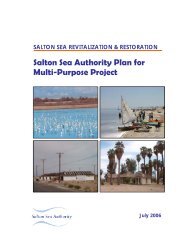Salton Sea Preliminary In-Sea Geotechnical Investigation
Salton Sea Preliminary In-Sea Geotechnical Investigation
Salton Sea Preliminary In-Sea Geotechnical Investigation
You also want an ePaper? Increase the reach of your titles
YUMPU automatically turns print PDFs into web optimized ePapers that Google loves.
SECTIONTWO<strong>Preliminary</strong> <strong>Geotechnical</strong> <strong>In</strong>vestigationA portable CPT system was used for the CPT soundings. The drill head on the drill rig was used to pushthe cone and casing was used to provide lateral support to the CPT rod string from the drill head to themud line. The soundings were conducted using a 20-ton capacity cone with a tip area of 15 squarecentimeters (2.3-inch 2 ) and a friction sleeve area of 225 square centimeters (34.9-inch 2 ). CPT datareduction and interpretation was provided in real-time on the barge deck. A photograph of the cone andthe CPT pushing operation is shown in Figure 5.The explorations were located using a Global Positioning System (GPS). The positions of theexplorations were located using the Latitude-Longitude decimal degree, North American Datum 1983(NAD 83) coordinate system. It is estimated that the accuracy of the horizontal locations of theexplorations is + 10-feet. <strong>Sea</strong>floor elevations were obtained by sounding the mudline with a weightedtape through the casing prior to drilling or CPT activities. The depth and elevation of the <strong>Sea</strong> bottom wasrecorded with respect to the <strong>Sea</strong> surface. The <strong>Sea</strong> surface was at approximately –227 feet MSL during theperiod of the field explorations.2.2.2 <strong>In</strong>-<strong>Sea</strong> BoringsEleven borings were drilled within the <strong>Sea</strong>. The locations of the borings are shown in Figure 2. Theborings were numbered to be consecutive with the CPTs. The borings were advanced to elevations ofbetween –274 and –407 feet MSL (30 to 149 feet below the seafloor). The borings were accomplishedusing rotary wash drilling techniques. Cuttings were flushed from the hole by circulation of a drillingfluid, which was then recirculated after the cuttings were removed in a settling basin.All of the borings were drilled under the direction of a certified engineering geologist. Samples of thesubsurface materials encountered in the borings were collected at approximately 5 to 10 foot intervals forfurther classification and laboratory testing. The samples were obtained using a Shelby tube sampler (inaccordance with ASTM D-1587) or a SPT sampler (in accordance with ASTM D-1586). The lowerportions of Boring 2 (the deepest boring) were also cored using a punch core 134-mm (5.28-inch) coringsystem.Additional details on the in-<strong>Sea</strong> borings are provided in Appendix A. A key to the log of the borings ispresented in Appendix A as Figure A-1, and logs of the borings are presented Figures A-2 through A-12.2.2.3 <strong>In</strong>-<strong>Sea</strong> Cone Penetration TestingSeventeen in-<strong>Sea</strong> CPT soundings where advanced to elevations between -270 and -332 feet MSL (32 to 67feet below the seafloor). The locations of the CPT soundings are shown in Figure 2. The CPT providedmeasurements of cone bearing (q c ), sleeve (f s ) and dynamic pore water pressure (u 2 ) at 2.5-centimeter (0.98-inch) intervals during penetration. All CPT soundings were performed in accordance with ASTM D-5778.Additional details of the CPT soundings are provided in Appendix B. A soil interpretation chart for theCPT data is provided in Figure B-1, and the CPT data are plotted in Figures B-2 through B-18.W:\27663042\00005-c-r.doc\1-Mar-04\SDG 2-3



